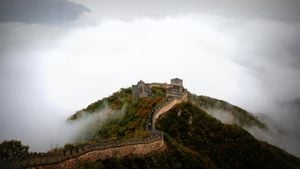British archaeologists have uncovered a remarkable tomb beneath the famed city of Petra, believed to have remained untouched for around 2,000 years. The excavation, conducted by researchers from the University of St Andrews, revealed the hidden burial site beneath the iconic Treasury, also known as Khazneh, which has long captivated visitors and moviegoers alike, famously serving as the fictional resting place of the Holy Grail in the 1989 film Indiana Jones and the Last Crusade.
This groundbreaking discovery, heralded as monumental by experts, unveiled 12 ancient skeletons along with various artifacts, including what appears to be a ceramic chalice closely resembling the Holy Grail depicted on screen. Professor Richard Bates, who leads the research, remarked, "The discovery is of international significance as very few complete burials from the early Nabataeans have ever been recovered from Petra before." The Professor noted how these findings could potentially fill the gaps in our knowledge about the Nabataeans, the people who constructed Petra.
The Treasury stands as the centerpiece of this ancient city, carved intricately from sandstone by the Nabataean kingdom over two millennia ago. Standing before its ornate façade, one cannot help but marvel at the ingenuity and artistry of this lost civilization. The team of archaeologists conducted remote sensing scans and obtained permission from the Jordanian authorities to explore the areas beneath this world heritage site, leading them to the surprising discovery of the tomb.
Upon entering the tomb, the archaeologists were astounded to find one skeleton clutching the ceramic vessel—an artifact often referenced when discussing the legendary Holy Grail. Josh Gates, the host of the documentary Expedition Unknown on the Discovery Channel, participated in the excavation, sharing his excitement: "When we spotted what looked like a chalice, all of us just froze. It looked nearly identical to the Holy Grail featured in Indiana Jones and the Last Crusade. It was the ultimate moment of life imitating art.
Further analysis of the ceramic vessel indicates it likely dates back to the 1st century BC, adding another layer of intrigue to the site. The tomb is believed to have been constructed as a mausoleum and crypt during the Nabataean Kingdom’s early years, likely associated with Aretas IV, who ruled from around 9 BC to AD 40. "Like many tombs in the valley, few remains have ever been found due to their subsequent use and reuse over the last two millennia," Dr. Tim Kinnaird from the University of St Andrews explained.
The discovery of this tomb has reignited interest not only among archaeologists but also among those who admire Petra's historical significance. Since the beginning of archaeological studies at the site, it was known there were voids beneath the Treasury, but the successful excavation of this tomb has provided tangible evidence of the Nabataean culture. Bates emphasized the potential of this find: "The burials, their goods, and the human remains can all be expected to help fill the gaps of our knowledge about how Petra came to be and who the Nabataeans were."
While many celebrate the find, caution has also been raised by some experts. Dr. Lucy Wadeson, known for her insights on Nabataean funerary practices, suggested media portrayal might have overstated the significance. She noted, "The [Jordanian] department of antiquities had already excavated two tombs there, and they left this one closed for future date; it’s not as if it’s something new." This assertion brings forth the complexity surrounding archaeological discoveries, and the interpretation of their findings can often vary widely.
Dr. Megan Perry, another leading expert on Nabataean burials echoed this sentiment on social media, expressing her discontent over the publicized excitement. "I’m not amazed," she stated, indicating the confusion around the tomb's significance, particularly to those who have vast experience within the field. She emphasized the importance of contextualizing such findings within the broader spectrum of archaeological knowledge.
The recent discoveries at Petra also highlight the enduring mystery of the Nabataeans themselves. This Arab tribe accumulated wealth and power by controlling trade routes for valuable commodities like frankincense and myrrh, connecting the Arabian Peninsula with the Mediterranean region. Despite their cultural significance, little is known about their written history or detailed societal structures, largely due to the scarcity of ancient texts directly attributing to them.
Some qualified speculation points toward the possibility of female-led burials among the Nabataeans, with findings at other sites like Hegra offering clues. Wadeson mentioned tombs uniquely dedicated to women could indicate fascinating societal dynamics, perhaps even power structures prioritizing matrilineal lines. Yet, much remains unknown about the Nabataeans’ beliefs, especially their ideas of the afterlife, which she wishes to explore more deeply if more evidence surfaces.
These discussions around the significance of the tomb and its artifacts weave through both the excitement of discovery and the scientific caution emphasized by experts. The interplay of emotions surrounding monumental archaeological findings is often palpable—fueled by the allure of ancient mysteries and the dedication of those who seek to unravel them.
Continuing studies and analysis will aim to provide fresh perspectives on the Nabataean civilization, more particularly how their cultural practices shaped their legacy. The hopes remain high for the revelations these buried treasures contend, with the urban legend-like aura of Petra attracting renewed attention as researchers strive to offer not only insights but also discrepancies surrounding this ancient civilization.
Josh Gates summarized the reverberance of the tomb discovery succinctly, stating, "Even in front of one of the most famous buildings in the world, there are still huge discoveries to be made." For many, this sentiment resonates beyond the mere findings of skeletal remains; it captures the enduring spirit of exploration, where history mingles seamlessly with the narratives we grow up believing, promises of more remarkable discoveries tinged with the enchantment of places steeped in antiquity.
While highlighting the importance of collaboration with Jordanian authorities, researchers aim to unravel the narratives surrounding the artifacts and bones unearthed at the tomb. Their efforts symbolize the commitment to preserving ancient cultures and illuminating long-forgotten stories set against the vibrancy of time’s passage. The future endeavors will rely on these findings as gateways to not just rewriting history but also grasping the full scope of Petra's enigmatic charm.



